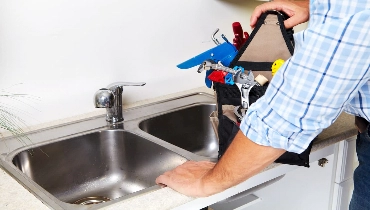
You use your kitchen sink multiple times a day, every day. In fact, it’s probably one of the most used and taken-for-granted parts of your home. Having a smoothly operating kitchen sink is critical for making meals, cleaning dishes, and for the overall happiness and well-being of your home.
When your kitchen sink is clogged, it’s not only a real inconvenience to you and your family but also a big mess that you likely don’t want to have to clean up.
To ensure you can get rid of your clogged kitchen sink quickly and with little stress, we put together this guide. In this article you will learn various methods for unclogging your kitchen sink, useful strategies to prevent your sink from clogging up again, and how the experts at Mr. Rooter Plumbing of Edmonton can help with all your plumbing needs.
How to Unclog a Kitchen Sink
Are you ready to learn a few easy DIY solutions for unclogging your backed-up kitchen sink? Continue reading to learn a few methods to get your drain back to normal.
However, if you’d rather not unclog your sink on your own—or if you feel like you need a little extra support—be sure to call the skillful and courteous plumbers at Mr. Rooter Edmonton. Our team is available 24/7 and can be reached by phone at 780-429-3600. Otherwise, we invite you to schedule an appointment online.
Step One: Remove All Standing Water
If you can’t easily access your drain because your kitchen sink is full of standing water, then you will have to remove all the water first. Standing water is the dirty water that accumulates in your sink if you continue to use it while it is clogged.
To empty your kitchen sink of standing water, follow these steps:
-
Protect your hands by putting on rubber gloves. This will ensure you don’t get burned from hot water and that you don’t cut yourself by touching a knife or some other sharp object in your sink.
-
Using a container—such as a jug, measuring cup, or bowl—start to bail out the water from your sink. Dispose of this water either in your toilet or in another sink in your house. Be careful not to clog your sink or toilet up with any excess food scraps that may be in the wastewater. Trap these food scraps using a basket catch and throw the waste out in the trash.
-
If your drain is not attached to a garburator, use your hands to get rid of any residual debris or food around the drain. Throw this in the garbage. If your drain is attached to a garbage disposal do not put your hand or fingers near the drain.
Step Two: Check the Garburator
Despite the fact that your garburator is meant to break down food to prevent clogs in your kitchen drains, it can still become blocked. This happens when an overload of food scraps has been put down the garburator, or items that should not be disposed of in a garburator have been forced into it. Food scraps that should not go into garbage disposal include eggshells, coffee grounds, bones, and grease.
Follow these steps to unclog your garbage disposal:
-
You must turn off your garbage disposal. This step must be completed before you do anything else to the sink. Never put your hand down the garbage disposal until it has been turned off.
-
Use a flashlight or your phone light to peer into the garburator drain. See if you can find what is blocking it.
-
If the sink is clogged because of food scraps, try manually turning the garburator to break the food down. The manual attachment for your garburator is found at its base. You will need an Allen key to turn the garburator. Alternatively, you can use pliers to remove excess food.
-
If your kitchen sink is clogged because there is jewelry trapped in the garbage disposal—such as a necklace or wedding ring—it's best to give our professional plumbers a call right away.
-
If you can’t turn the garburator manually to get rid of the clog, try using a plunger. Before plunging, clamp the dishwasher drain line to stop dirty water from flooding into your dishwasher.
-
Use water to flush the garbage disposal after removing as much of the clog as possible. This will help get rid of excess debris.
-
Never put chemicals down your garburator as this could break it.
-
If you try plunging your garburator and the sink is still clogged, contact us for professional help.
Step Three: Start with Boiling Water
If your sink is draining slowly and if you don’t think the clog in your kitchen sink is too big, try using boiling water first to knock away any debris. Using boiling water—as opposed to hot or room temperature water—is key as the heat will help break down food and solidified grease. Flush the water repeatedly through the drain to see if this gets rid of the clog.
Step Four: Try Baking Soda and Vinegar
The chemical reaction between baking soda and vinegar is a powerful way to unblock small clogs. This technique is beneficial because it saves you the effort and frustration of using a plunger or drain snake, and it doesn’t use harmful chemicals. You can only try this method if you can get the water level below the basket strainer because you need to be able to trap it in the drain.
Practice the following steps to unclog your kitchen sink using baking soda and vinegar:
-
Prep the drain by pouring boiling water into it. This begins to loosen debris and will help the baking soda and vinegar be more effective.
-
Pour one cup of baking soda into the sink. Push the baking soda down the drain with a kitchen tool like a large spoon or spatula.
-
Next, add one cup of vinegar down the sink.
-
Quickly put a stopper into the drain. The idea is that you want the chemical reaction to go down the pipe, not back into the sink.
-
Once the chemical reaction has settled, finish by flushing more boiling water down the sink.
Step 5: Use a Plunger
If you tried flushing the clog away with boiling water or the baking soda/vinegar combo and it still stubbornly persists, then you will have to resort to plunging.
Follow these guidelines for plunging your clogged kitchen sink:
-
Ensure you choose the right plunger for the job. There are three different plunger varieties: an Accordion plunger, a toilet plunger, and a flat-bottomed sink plunger. You will want to use the flat-bottomed sink plunger to clear your blocked drain.
-
Pour a small amount of water into the sink. Only a few inches will do—this is to help the plunger suck onto your drain.
-
Plunge the drain three to five times.
-
If you have a garburator, run it after plunging the drain to see if the block is cleared.
-
You can test to see if your kitchen sink is unclogged by running a small amount of water into it and checking if the water drains.
-
If the block is still in your drain, repeat this process three additional times.
-
If after trying to clear your clogged kitchen sink a few more times with the plunger method and it still hasn’t worked, you’ll want to try cleaning the P-trap, use a drain snake or call an Edmonton plumber.
Step 6: Clean the P-Trap
The P-trap is what it sounds like. A “P” (or sometimes recognized as a “U”) shaped portion of pipe that traps debris and food to prevent clogs from forming deeper in your plumbing system. Additionally, the P-trap catches precious items that may fall down your kitchen sink—like a necklace or wedding ring—and stops sewer gasses from getting into your home.
Yet, the P-trap can become clogged from time to time—especially since its role is to catch food waste and debris. The best way to check if your P-trap has become clogged is to take it apart and clean it manually.
Use this guide to clean out a P-trap:
-
Place a bucket below your sink, ensuring it’s below the P-trap. This will catch any food, debris or water that may still be in your pipes when you remove the trap.
-
Unscrew any connections that hold the pipe to the wall and surrounding pipes.
-
Carefully take out the P-trap and look to see if there is a blockage.
-
If your P-trap is clogged, wear rubber gloves and clean out any gunk. Throw away food scraps or solidified grease into your garbage. Do not put it down the sink.
-
If your P-trap isn’t clogged, then you will have to try a drain snake to reach more deeply into your plumbing system or call a professional plumber for assistance.
Step 7: Use a Drain Snake
A drain snake is used to help you clear stubborn blocks that can’t be flushed with a plunger or reached easily. This tool looks like a coiled, metal rope and generally has a manual crank on one side. A DIY alternative to a drain snake is a straightened metal hanger with a hook bent into one side.
Follow these steps when using either a drain snake or metal hanger to unblock your clogged pipe:
-
Get your tools ready, either by unwinding the drain snake or bending a metal hanger into the right shape.
-
Start feeding the drain snake or hanger (hook side) into the pipe.
-
Feel around for the clog. Once you feel the block, pull the wire up or begin winding the drain snake. You may have to repeat this process a few times to get the entire clog out of the drain.
-
After getting rid of as much of the block as possible, pour boiling water down the sink to flush away any remaining debris.
Step 8: Call the Pros at Mr. Rooter Plumbing of Edmonton
If you are still struggling with your stubborn clogged kitchen sink—despite trying the above techniques—or if you would rather have the experts at Mr. Rooter Plumbing of Edmonton unclog the drain instead, we invite you to give us a call or request a job estimate online. It’s our pleasure to save you the time and hassle it takes to unclog a messy drain.
What Causes a Clogged Kitchen Sink?
Now that you know how to clear away your clogged kitchen sink and/or garburator, it’s beneficial to understand how your sink became clogged to begin with.
Grease Build Up
Grease solidifies at room temperature and is not soluble in water. So, if you are draining liquid oil or fat from foods—like bacon—the grease will not flow away through your pipes. Rather, it will start to accumulate on the inside of your plumbing system and cause a clog. Since grease is quite sticky, other kinds of debris like food scraps could get stuck in the solidified grease as well. This contributes to clogging your kitchen sink.
Instead of putting cooking oil or animal fats down the sink, it’s better to dispose of grease by pouring it—while still in a liquid state—into a jar. Once the grease has cooled and solidified, throw that jar into the garbage.
Food and Debris Stuck in the Drain
Food scraps tend to get stuck in your drain—especially since your kitchen sink is where you do the most meal preparation and washing up. While some foods are disposed of easily in your garburator, putting too much food in the garbage disposal at once or throwing away the wrong kinds of food in your garburator could cause a clog.
Foods that should never be disposed of in your kitchen sink/garbage disposal include:
- Pasta
- Potato peels
- Coffee grinds
- Bones
- Celery
- Eggshells
- Fruit pits
Toys and Foreign Objects
Little kids have a way of getting their toys stuck in the strangest of places—including your kitchen sink. Perhaps your little one wanted to see what happens when they put a toy in the garburator, or maybe you were using your sink as a baby bath and a toy got stuck. Or, maybe your wedding band or engagement ring slipped off and went into the sink while you were washing dishes.
Any household item, toy or precious object is not meant to go into your garburator or sink. These objects will block your pipes and sometimes get stuck in the P-trap.
How to Prevent Future Clogs
The best way to ensure you don’t have to deal with another clogged kitchen sink is by preventing a block from happening in the first place. Keep these tips in mind to prevent clogging your drain in the future:
- Run water while the garburator is working. Running water while using the garbage disposal will help flush away food scraps.
- Don’t over stuff the garburator. Limit the amount of food items you put in a garbage disposal to half a cup at a time.
- Don’t put specific foods down the drain. As mentioned earlier, it’s very important that certain foods don’t go into your garburator. This is typically any FOG (fats, oils, grease) and food scraps that don’t break down. They could either damage the garburator or clog it.
- Invest in regular maintenance. Taking care of your plumbing is one of the best ways to prevent large clogs in your kitchen sink. Try flushing boiling water down your sink from time to time, or using the baking soda/vinegar method to regularly clean out your pipes.
Trust Mr. Rooter Plumbing of Edmonton for Your Plumbing Needs.
If you’re dealing with a clogged kitchen sink, get in touch with the professional and expert team at Mr. Rooter Plumbing of Edmonton. We look forward to making your acquaintance and solving all your plumbing problems.
Give us a call today or request a job estimate online for more information.

